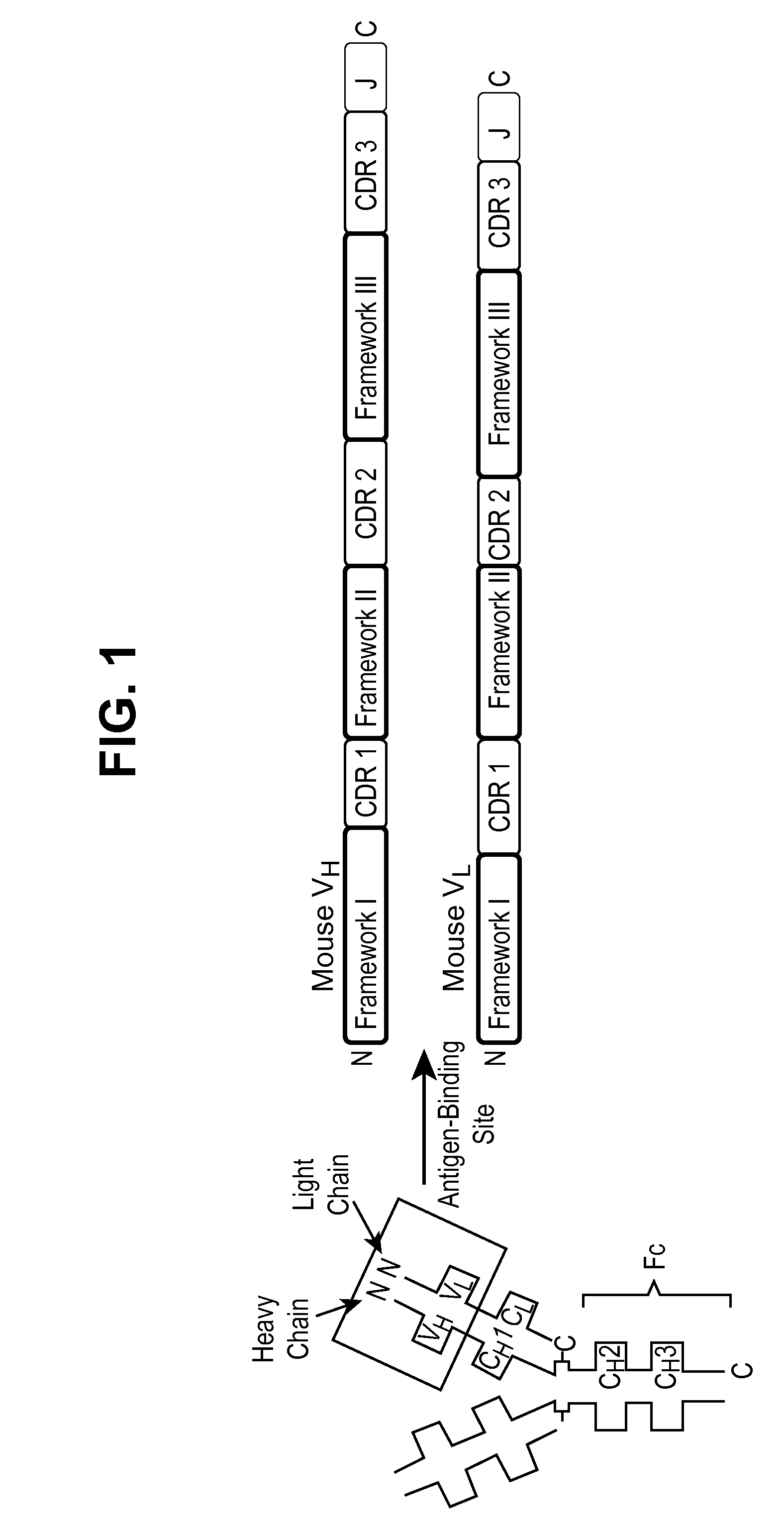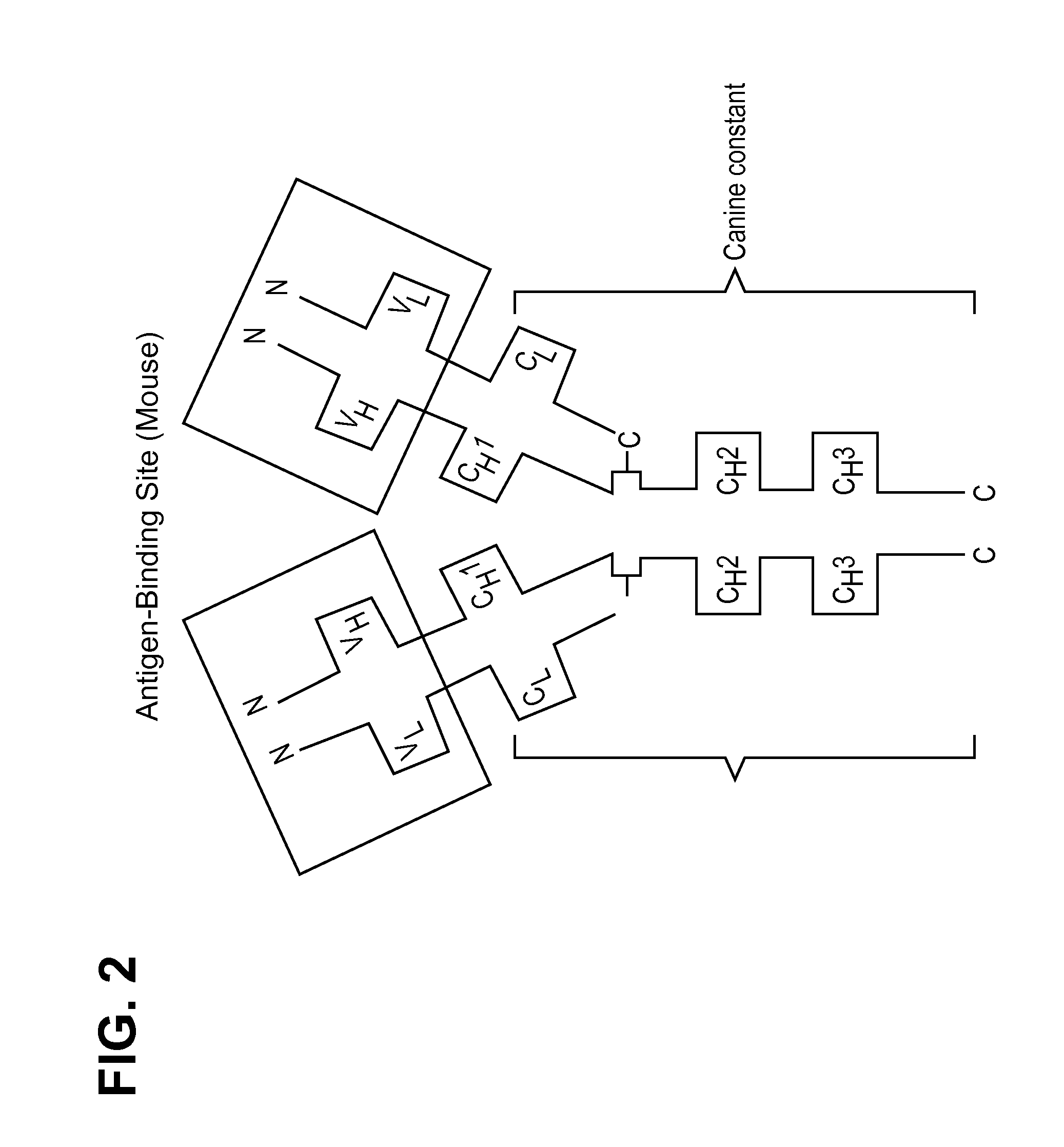Caninized Anti-ngf antibodies and methods thereof
a technology of anti-ngf antibodies and antibodies, applied in the field of immunology, can solve problems such as lameness and pain, disability and clinical signs of lameness
- Summary
- Abstract
- Description
- Claims
- Application Information
AI Technical Summary
Benefits of technology
Problems solved by technology
Method used
Image
Examples
example 1
Identification of Mouse Monoclonal Antibody Recognizing Canine Nerve Growth Factor (NGF)
[0289]A series of murine mAbs were produced against mature, human β-NGF (U.S. Pat. No. 7,727,527). Once these mAbs were generated, they were subjected to a variety of analyses, including epitope mapping and in vitro tests for 1) binding to NGF and 2) ability to block binding of NGF to its receptors TrkA and to a lesser extent p75 and 3) assessment of functional antagonism associated with NGF blockade (blockade of TrkA autophosphorylation, blockade of NGF-dependent survival of neurons). Based on these results, it was found that mAbs that bind to variable regions 1 (β-hairpin turn A′-A″), 4 (β-strands C and D) and the carboxy-terminus are capable of blocking TrkA and p75 binding. Molecular modeling of the binding epitope on NGF of one of these murine mAbs, RN911, is shown in FIG. 6A. RN911 was shown to be efficacious in preclinical rodent models of pain associated with arthritis, cancer, surgical i...
example 2
Caninization Strategy
[0301]The generation of anti-drug antibodies (ADAs) can be associated with loss of efficacy for any biotherapeutic protein including monoclonal antibodies. Comprehensive evaluation of the literature has shown that speciation of monoclonal antibodies can reduce the propensity for mAbs to be immunogenic although examples of immunogenic fully human mAbs and non-immunogenic chimeric mAbs can be found. To help mitigate risks associated with ADA formation for the mouse anti-NGF, RN911, monoclonal antibody provided herein, a caninization strategy was employed. This caninization strategy is based on identifying the most appropriate canine germline antibody sequence for CDR grafting (FIG. 3). Following extensive analysis of all available canine germline sequences for both the heavy and light chains, germline candidates were selected on their homology to RN911, and the CDRs from RN911 were used to replace native canine CDRs. The objective was to retain high affinity and c...
example 3
Caninization of RN911 Antibody
[0302]Synthetic constructs representing the caninized variable heavy and light chains of mAb RN911 were made. Following subcloning of each variable chain into plasmids containing the respective canine heavy or kappa constant region, plasmids were co-transfected for antibody expression in HEK 293 cells. The canine heavy chain constant region of the present invention are not limited to any particular subtype, however in some embodiments the canine heavy chain is described as SEQ ID. NO. 45 or SEQ ID NO. 48. The canine kappa light chain constant regions are not limited to any particular sequences, however in some embodiments of the present invention the canine kappa constant region is described as SEQ ID. NO. 47. Frameworks used for mAb “canE3M65” expressed in HEK 293 transient expression system and retained NGF binding upon caninization. (Seq ID NO.33 “CAN-E3M-VL”, SEQ ID NO. 34. “CAN-N2G9-VH”).
[0303]In contrast, the germline sequences used for the can618...
PUM
| Property | Measurement | Unit |
|---|---|---|
| Fraction | aaaaa | aaaaa |
Abstract
Description
Claims
Application Information
 Login to View More
Login to View More - R&D
- Intellectual Property
- Life Sciences
- Materials
- Tech Scout
- Unparalleled Data Quality
- Higher Quality Content
- 60% Fewer Hallucinations
Browse by: Latest US Patents, China's latest patents, Technical Efficacy Thesaurus, Application Domain, Technology Topic, Popular Technical Reports.
© 2025 PatSnap. All rights reserved.Legal|Privacy policy|Modern Slavery Act Transparency Statement|Sitemap|About US| Contact US: help@patsnap.com



